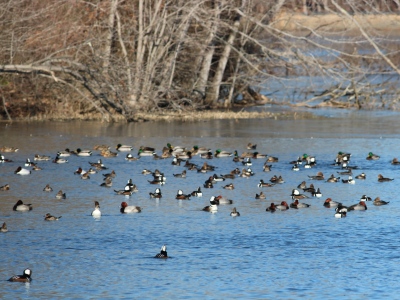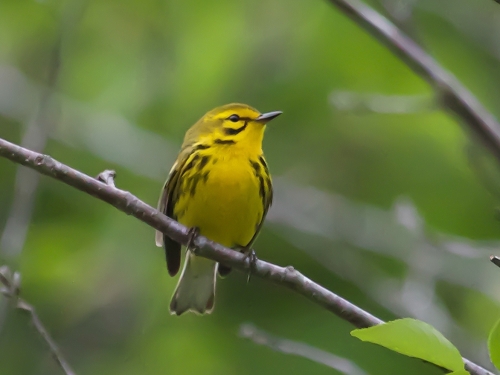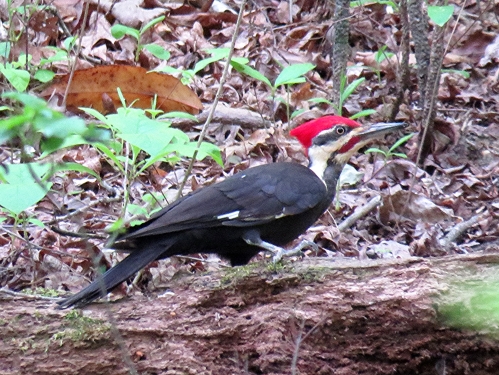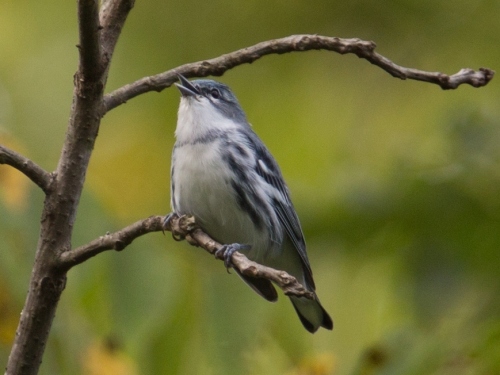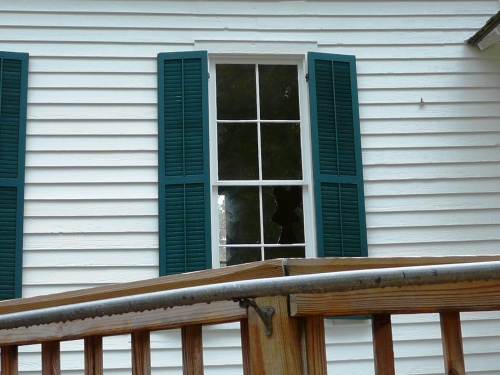Since heading west to Washington in 2015, what I miss most in Winston-Salem is birding with good friends in places like Bethabara, Salem Lake and Archie Elledge. So, I was pleased when Shelley Rutkin expressed interest in visiting Mary and me and seeing some of our western species. We settled on late August as a time likely to produce good weather and some of Shelley’s target birds. Little did we realize just how exciting our bird search would become.
Shelley’s late-night arrival called for a relaxed approach to bird finding on her first day. We headed to the Big Four Ice Caves about 45 minutes away in the national forest. It instantly became one of my favorite spots out here, and it was likely to produce a life bird for Shelley. Unseasonable heat kept the species count down. However, we were rewarded with good looks at several Black Swifts – Life Bird #1 for Shelley.

Shelley Rutkin finds Black Swifts at the Big Four Ice Caves.
The next day, we headed to Mt. Rainier National Park about three hours away. Mary and I have looked forward to going there ever since we arrived in the Seattle area, and it has some bird species that we do not see west of the Cascades. We stopped for a picnic lunch at the beautiful woods of Federation Forest State Park, where we saw our first Gray Jay of the trip.

A Gray Jay was looking for a snack at Federation Forest.
We arrived at our Crystal Mountain Resort lodgings by early afternoon, then drove to the park’s Sunrise Visitor’s Center. A Clark’s Nutcracker greeted us as we exited the car. A late afternoon walk along the Silver Forest Trail provided magnificent views of Mt. Rainier’s summit, Mt. Adams and the White River valley, along with sightings of Mountain Chickadees, Audubon’s Warblers and Common Ravens. Ominously, although it was clear above, we could see smoke plumes from nearby forest fires.

The White River flows with glacial melt from Mt. Rainier.
The next morning dawned bright and beautiful at the park. For our bird hike, we chose the Sourdough Ridge and connecting Mt. Fremont Trails. This route offered us the best opportunity for a Prairie Falcon and perhaps even some White-tailed Ptarmigans. At Frozen Lake, Mary headed back, but Shelley and I proceeded on our quest. Just as we turned the corner and headed up toward Mt. Fremont, we spied a pair of Mountain Bluebirds on a fence line.

A pair of Mountain Bluebirds were hawking insects at Frozen Lake.
“Moderate” soon became “strenuous,” at least in our minds, but there was no stopping us. We plunged ahead over treacherous scree toward the Mt. Fremont lookout tower.

We hiked past this stone figurehead on the Mt. Fremont Trail.
Shortly before the summit, we spied two raptors soaring over a far ridgeline. Our Prairie Falcons? Perhaps, based on their pale coloring, but more likely Red-tailed Hawks. Alas, we saw no ptarmigans either, but we did see Mountain Goats and a cute Pika. And we did conquer Mt. Fremont!

Pikas are cute little mammals most closely related to rabbits.

We persevered to reach the Mt. Fremont Lookout.
The next morning was serendipity, as we drove park roads before breakfast looking for another Rutkin life bird, Sooty Grouse, or at least a Ruffed Grouse. Nothing along the roads, so we headed toward a trail at Sunrise Point as our last best chance. Not 50 yards in, I spied a bird walking down the trail. “Shelley, there’s your grouse!” We snapped dozens of photos as the male Sooty foraged in the trailside vegetation.

Shelley’s Sooty Grouse lifer poses for our cameras.
Our morning wasn’t done. A mile down the mountain, I jammed on the brakes as two woodpeckers moved through the trees – American Three-toed Woodpeckers. We both had seen only one previously in our birding lives, but these were the first in Washington.

Shelley was able to get this photo of an American Three-toed Woodpecker.
Mt. Rainier was all it has been touted to be. Many wildflowers had passed their peak, but the meadow at Sunrise still was full of Pasque Flower, Newberry’s Knotweed, Cascade Asters and Magenta Paintbrush. Shadow and Sunrise Lakes reflected light from the valleys below. And always, Emmons and Winthrop Glaciers on the mountain glistened in the background. We also lucked out with the clear skies. A few days later, the smoke had moved in and Crystal Mountain was being evacuated.

Magenta Paintbrush was still in bloom on Sunrise Meadow.

Butterlies were surprisingly scarce, but this Hydaspe Fritillary was a beauty.
The first morning at Sunrise, we had encountered a birding acquaintance. She alerted us that Ryan Merrill, our area eBird reviewer, had found a Swallow-tailed Gull at a North Seattle park on Puget Sound. I had seen this species in its native Galapagos Islands off of South America, but “Wow!” The only two previous sightings in North America were in California. People on the east coast already were booking flights. Nathan Gatto texted that in our position he would check out early and head to the coast. We had demurred with fingers crossed that it would stick around.

This Swallow-tailed Gull is only the third one reported in North America.
But would it? The next day, when we were grousing, the gull had disappeared. We headed home as other birders searched the Seattle area waterfront. Joy! Mid-afternoon, it was located a bit to the north – on a refinery pier at the southern tip of my home Snohomish County. However, viewing access was limited, treacherous and likely illegal, across railroad tracks. We also were caught in brutal Friday holiday traffic. We would have to wait.
On Saturday morning, no Swallow-tailed Gull at the Seattle park, the refinery, or even along Edmonds beaches a mile to the north. The search was on again. We decided to go to Edmonds, anyway, while we awaited any news. The Swallow-tailed Gull may be the most beautiful gull in the world, but the gray-feathered, red-billed Heerman’s Gull belongs in the pageant and Shelley had seen few of this western species. There were dozens roosting along the Edmonds jetty.

Dozens of Heerman’s Gulls roost on the Jetty at the Edmonds Pier.
Still no word in the afternoon, so it was off to the Everett Sewage lagoons to look at Western Sandpipers and an assortment of ducks, including Cinnamon Teal. The water now was too high to add an uncommon Willet to my county list at Tulalip Bay, so we headed over to Everett’s Marine Park. At least there, Shelley could add California Gull and Ring-billed Gull to her Washington list.

The Swallow-tailed Gull seems to enjoy the company of California Gulls.
Sitting in the water with Californias just a few yards from the parking lot was a smaller gull with a chocolate-brown head, a bright red eye ring, black wing tips and a two-toned bill of black and silver with a prominent white spot at its base. And, when it fluttered, we saw red legs and a u-shaped tail. We had relocated the Swallow-tailed Gull about 15 miles north of where it was last seen. Gorgeous!

The Swallow-tailed Gull takes a brief flight in Everett.
Soon after we posted word on our local Tweeters listserv and on Facebook, other birders began to arrive. Suddenly, the gull hopped out of the water onto the edge of the parking lot not 20 feet away. Cameras clicked away from close range capturing this remarkably photogenic bird until it eventually returned to the water. The young man next to me turned out to be Amar Ayyash from Chicago and one of our foremost gull experts. Instantly, we had street creds in the birding community in Snohomish County and nationally. What an amazing end to the day!

Dozens of birders responded to our gull alert.
Needless to say, the next three days were anticlimactic. We canceled a planned return east of the mountains because of the smoke and continuing heat. Instead, we stayed around home and added birds to Shelley’s state list.

Shelley really wanted to see a Chestnut-backed Chickadee, and she captured one with this photo.
Chestnut-backed Chickadees and Red-breasted Nuthatches visited feeders at a local park. Both yellowlegs and Short-billed Dowitchers foraged on Skagit County mudflats. Black-bellied Plovers and Caspian Terns rested on a sandy spit. Ospreys and Great Blue Herons fed their chicks at Marine Park. And, our adventure together ended with a Marbled Murrelet and Mew Gull at a nearby beach.

The Great Blue Heron rookery was still busy at Marine Park.
The mountain scenery was beautiful, the Swallow-tailed Gull was amazing, and Shelley’s state bird list now stands at 81. However, just as nice was taking it all in with a long-time friend.

Mary, Shelley and I walked the Silver Forest Trail at Mt. Rainier.
Addendum: More than a week later, the Swallow-tailed Gull is still here. So long as the squid are easy to find each night and Seattle’s infamous rain holds off, it just may be here awhile.
Read Full Post »











